Over the last 15 years the South Boston Seaport district, once an ocean of parking for south shore commuters, has finally began to develop and is now experiencing growing pains. New hotels, offices, and soon residences have been built at a breakneck pace. In the 1990s, during the Big Dig, planners saw the potential of the empty land sitting next to downtown Boston and South Station. A new transit tunnel was proposed connecting the area to South Station which was designed to uses electric buses that would continue on to Logan Airport via the new Ted Williams Tunnel. The Silver Line was to be one of the first Bus Rapid Transit (BRT) lines in the country and the Feds wanted to use it as a showpiece. Seeing this the MBTA realized that their only source of new funding would be for BRT lines and soon they expanded their vision to include the long delayed Washington St Orange Line replacement with a scheme to connect the Seaport tunnel with a new service through downtown and south to Dudley Sq. The Washington St service, all above ground, opened in 2001 and the tunnel opened a year later. But the connection, a tunnel from Washington St to South Station, was doomed to failure. The project involved destroying the existing, but abandoned, Tremont St Tunnel (part of the original subway) and building a giant underground loop below Boston Common because the turns in the tunnel would be too tight for buses. The cost far outweighed the benefit as there was very little demand from Roxbury to the Seaport. The Feds finally ended support for the tunnel and the MBTA gave up their BRT crusade.
As the Seaport grew it became clear that the Silver Line wouldn’t be enough. The Silver Line runs in a 1 mile tunnel from South Station to D St where it crosses D St and enters into a private road known as Silver Line Way. The grade crossing was a way to cut costs in the original design but has caused traffic issues as the Seaport builds out. The buses must then retrace their route on surface streets to access the Ted Williams Tunnel due to the Mass State Troopers refusal to allow the buses to use their private highway on ramp. The use of that ramp would cut an extra mile off the trip. On the return journey there is no closer off ramp to use so buses must exit at B St and pass in front of the entrance of the World Trade Center Station before going back to Silver Line Way, only to enter the tunnel to WTC again. This roundabout route was never well thought out but didn’t matter all that much when there wasn’t much traffic on the streets.
The streets themselves are another matter. As it was left up to the developers to create their own side streets only the arterials were designed, and in typical fashion they were designed as wide suburban arteries with four lanes plus a turning lane and parking lanes on each side. Seaport Blvd even features a wide median but this has always been a blank concrete slab rather than a planted tree lined feature. Bike lanes were installed but due to the prebuilt sidewalk bulges they are on the street side within the door lane. The Seaport is quickly turning into a dense urban neighborhood but its streets are stuck in the suburbs. Ideas are starting to be floated about what to do with the Seaport but they tend to be, literally some times, pie in the sky such as a gondola system from South Station. Ironically, if the city was to install bus lanes along Seaport Blvd and Summer St the Silver Line would have a quicker journey from the Airport to South Station. The tunnel, therefor, should be used for the Green Line.
Red-Blue Connection & the Essex St Connector
The Boston subway was designed with four major downtown transfer points: Park St, Government Center, State, and Downtown Crossing. As Boston had a strong hub-spoke transportation network this made sense and has worked for the last century. But as areas away from downtown begin to develop, such as the Seaport and Kendall Sq which are both along the Red Line, this system is no longer balanced and the transfer stations are beginning to strain under the crowds. Accessing the Silver Line at South Station often requires a transfer at Park St (Green Line) or Downtown Crossing (Orange Line) and these are so overcrowded that the platforms become dangerous. The crowding delays trains as riders try to squeeze into already packed cars. Planners have even toyed with the idea of combining the two stations with one giant platform but the narrow Winter St under which the Red Line runs would not have space for such a station and it’s questionable how helpful this would even be.
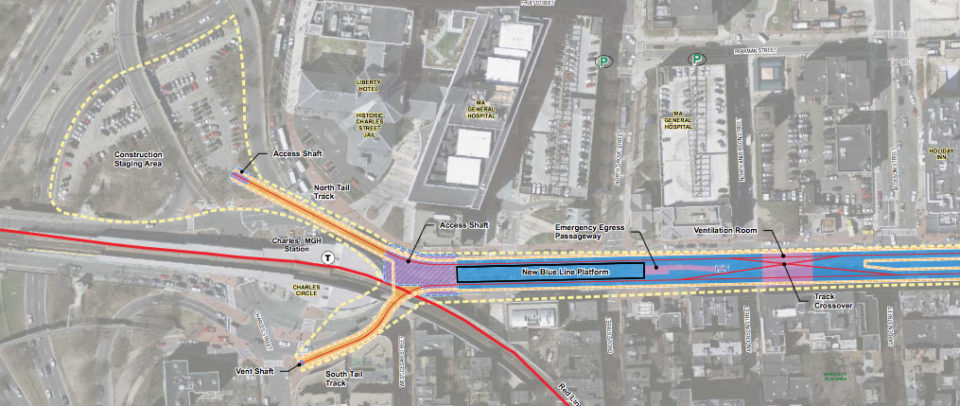
The solution is to create new transit nodes which can take transfer pressure away from the core. In the process this will open up new radial lines that will serve the two new business districts. The first node will be to extend the Blue Line west along Cambridge St to Charles/MGH. This extension was part of the original settlement between the Commonwealth and Conservation Law Foundation when the Foundation sued over emissions mitigation during the Big Dig. Under the agreement the Commonwealth agreed to build the Green Line extension to Medford, the Red-Blue connection, and restore the Arborway streetcar. After the Big Dig ended the Commonwealth went to court to ask that it only need to build one transit extension and the Green Line to Medford was chosen over the Blue. As Kendall Sq continues to grow the Blue Line extension will help by letting riders from the north and northeast reach the Red Line and avoid Park St.
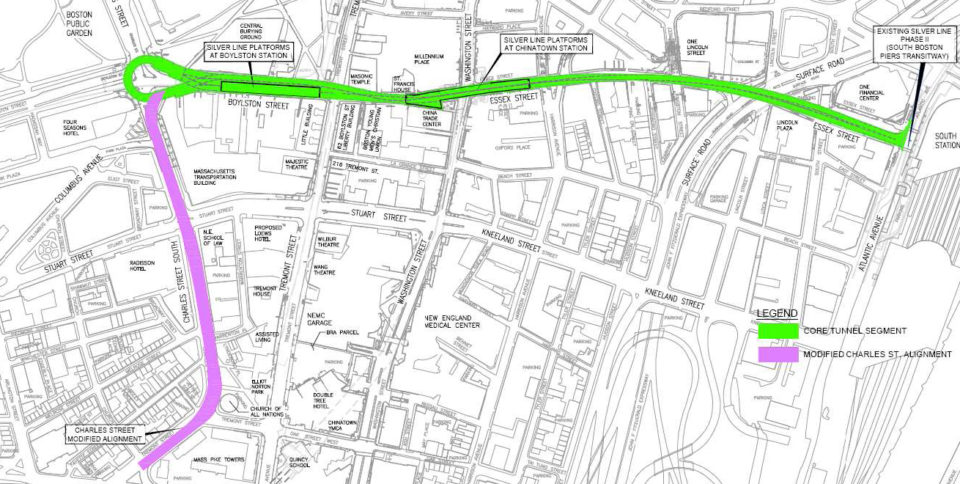
The second solution is to build on the bones of the dead Silver Line Phase III with a much simpler tunnel from the Green Line between Arlington and Boylston St to South Station. When this section of the Green Line was built there were provisions built into the walls to allow for a branch to Post Office Sq but nothing more was ever built. Also along this section are the remains of two separate portals which once served streetcars from the west before the subway was extended. This extra space within the tunnels is a perfect location for a junction to be built with two tracks descending as they head east. This new tunnel must dive deep to pass beneath the existing abandoned Tremont St tunnels. Boylston St between Tremont and Washington is only 40 feet wide so to fit with a new station the tunnels must be bi-level with the Seaport bound track on the upper level and the Kenmore bound track on the lower. A new mezzanine will connect the Green Line at Boylston and Orange Line at Chinatown allowing riders to once again avoid the Park-Downtown Crossing mess.

As the Silver Line was designed with Phase III in mind, there is space along Essex St above the Central Artery tunnels for the transitway and at South Station there are bellmouths in the walls of the Silver Line for this connection. The Silver Line tunnel through the Seaport was also built with light rail conversion in mind so all that is needed is for tracks to be added to the tunnels (and possibly a second set of power wires in the ceilings). While threading a new tunnel and station along such a narrow street in the congested heart of Boston is no simple task it is the only difficult section of the project.
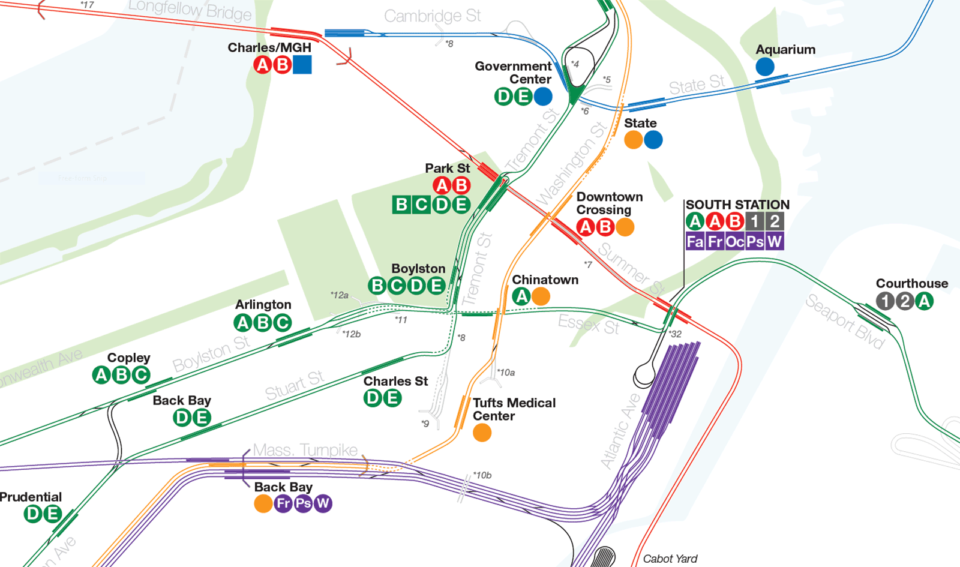
Once connected a branch of the Green Line will be rerouted to the Seaport. At Silver Line Way is a bus loop which can be converted to a trolley loop with space for layup tracks. As the new extension only adds 1.5 miles to the Green Line network the trolleys will still have access to existing maintenance facilities so no new yard is needed in the Seaport. Creating a one seat ride between the Seaport and Back Bay has other advantages as well. The Seaport has a number of new hotels to support the giant convention center but these are also useful for traveling business people who need to reach the Financial District and Back Bay. Tourists will have a one seat ride to Fenway Park or for parents whose children go to BU or Northeastern they can stay in the Seaport and not have a complicated multi-line ride. Commuters from the south will no longer have to change at Park St but instead can change at South Station.

The Silver Line was built to allow both buses and light rail to run together but this may have some operational complications. Because the buses don’t run along a fixed guide way they are limited to 10-15mph. Light rail can go much faster while on tracks so mixing the two will cause delays. What is then needed, should this prove unworkable, is a new network of street level bus lanes throughout the Seaport. Such lanes would vastly improve Silver Line running time as the buses no longer have to double back and can run straight from the Ted Williams Tunnel to South Station with stops in between.
A Greater Green Line Network
The Essex St Connector is the most vital part of fixing the downtown congestion but it is far from the only issue facing the Green Line. As the first subway in the US the Green Line is really a collection of different transit ideas all built at different times. Originally conceived as a way to remove streetcar congestion on the surface streets the Green Line operated dozens of different routes, some which terminated at Park, others at Scollay Sq (now Government Center), and finally some to North Station. As rapid transit began to change how people commuted fewer were using streetcars and more were riding the heavy rail lines which opened up the suburbs to faster transit. The dozens of streetcar routes were eventually whittled down to four but when the new Riverside Branch opened it proved so popular that trains had to be taken off streetcar routes, thus dooming the A Branch.
Due to the mixing of service, streetcar and light rail, and the multiple bottlenecks as new branches were added, the Green Line is running below peak efficiency. At Copley Sq E trains must pass in front of all others as it changes to Huntington Ave, at Park St 4 tracks merge into 2, at Government Center terminating trains must loop back but have no extra track on which to layup. The B Branch has stations so close together that it is often better to walk. And on all sections that run along the streets trains must wait at traffic lights like any other vehicle. So while the Essex St Connector is a short term solution, long term the Green Line needs much more work.
The first step is creating a separate system for streetcars (B/C/E) and light rail (D). While most people often use these two terms interchangeably there is a difference. Streetcars are often lighter than light rail cars and can run in mixed traffic or along medians but adhere to traffic signals. Light rail runs along a dedicated right-of-way and has no (or as few as possible) grade crossings. Trains can be longer and faster. Many times both systems work together as light rail trains can run on dedicated ROWs until they reach downtown and then operate on city streets.

When the Huntington Ave Subway was built in the late 1930s it was originally designed to have a second section along Stuart St to Tremont St where it was to connect with the Tremont St Subway using the existing flying junction south of Boylston St station. This would allow trains to not have to pass in front of one another and Huntington Ave trains could use the separate outer tracks to Park St, thus eliminating any congestion with other lines. Due to the limited WPA funds a simpler connection was made at Copley Sq which forced trains to cross at grade. Additionally plans had been proposed as far back as the 1920s to extend as subway down Huntington Ave to Mission Hill and on to Brookline.

Building a new Stuart St Subway from Tremont to Huntington Ave and extending Huntington Ave to Brookline would create a second trunk through Back Bay and allow both D and E trains to have separate access to the outer tracks at Park St (the original tunnel would be modified so that any future service south to Dudley Sq could be added without conflict). This doubles capacity on the B and C Branches and as it is the D and E which are to be extended to Medford and Union Sq, respectively, then B trains can be terminated at Park St while C train can be rerouted to the Seaport. The street running section of Huntington Ave will be replaced with a tunnel to Brookline Village where the D will be rerouted through a new tunnel bellow Route 9. This new tunnel will be part of a larger complex which comprises of a new loop for shuttle trains to keep servicing Longwood and Fenway Stations, looping back at Kenmore Sq. The Brookline loop will also have switches in place to allow through running to Kenmore during Red Sox games. While complex, no land would need to be taken for the Brookline loop as the portals would be built along the existing tracks and the new tunnel would run under the Boylston St Park to reach Rt 9. The loop itself would run around the large 10 Brookline Pl office building and along Pearl St. A bi-level station would allow for cross platform transfers to the shuttle. West of the station would be a layup track for short turning rush hour trains. While complex this layout allows for maximum operational flexibility.

Having two branches along the Riverside Line means that one can be used to replace the Needham commuter rail line with light rail. As outlined in the recent Transit Matters Regional Rail report the Needham Line will eventually need to be replaced with rapid transit due to capacity constraints along the Northeast Corridor. The Green Line can add service through Upper Falls and replace the existing service to Needham Junction while the Orange Line will be extended to West Roxbury and possibly on to Dedham (more on this later). A new flying junction will be built at Newton Highlands with infill stations in Upper Falls and Gould St-Route 128. As this section of the Riverside Line has few stations the trip will only add a few minutes to the commuter rail journey and this will be offset by much higher frequency.
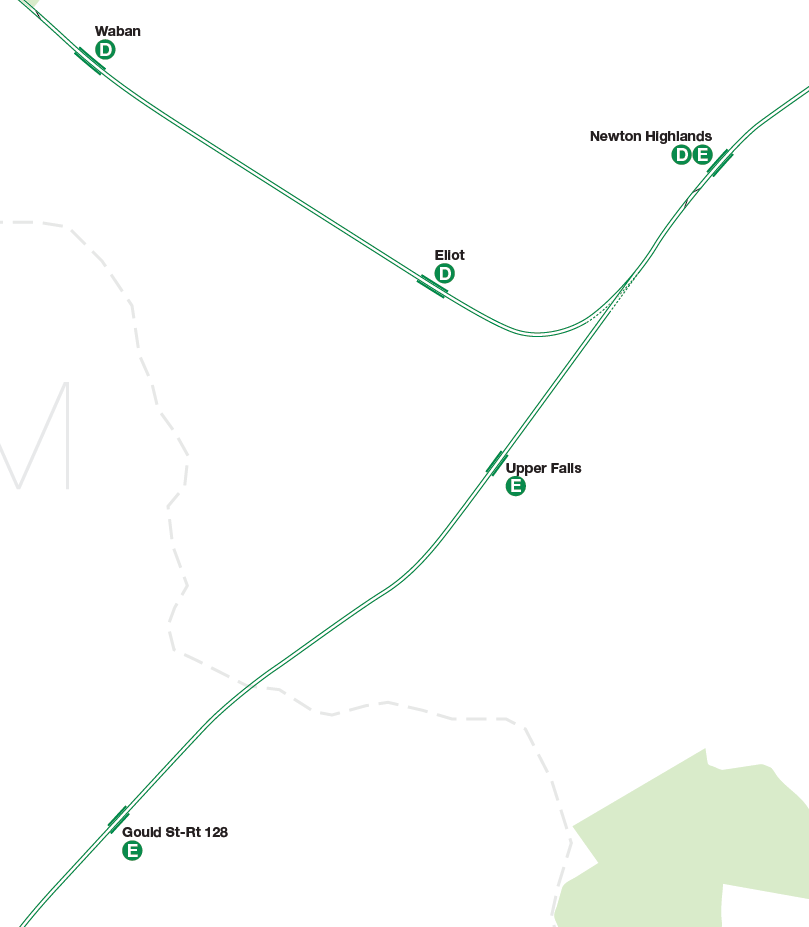
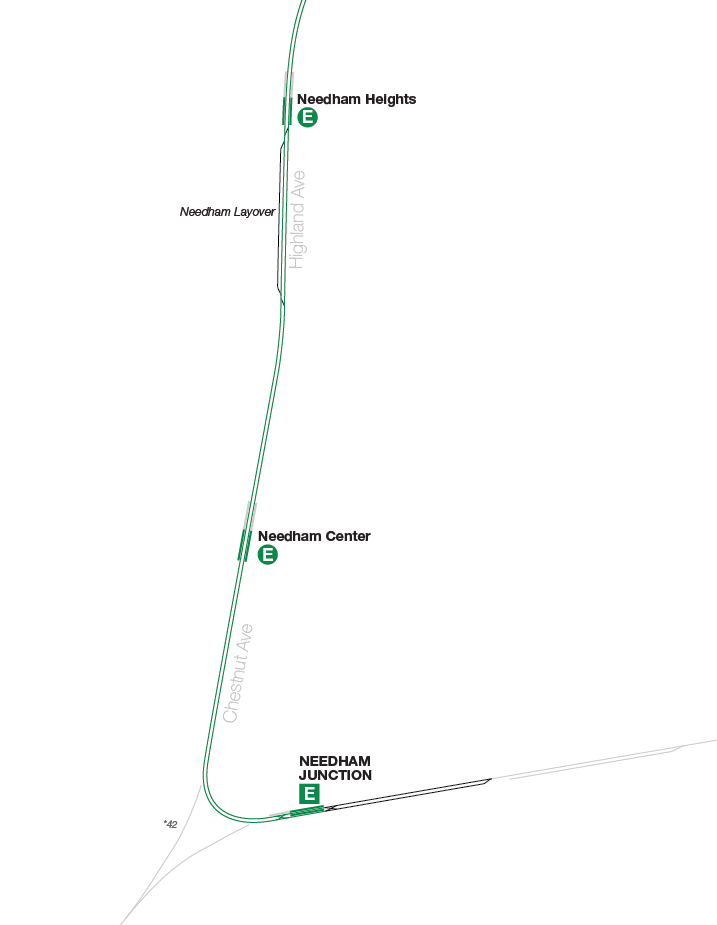
A New A Train
The new capacity afforded by the Huntington Ave extensions will allow for more B and C train service. It will also allow for the restoration of the A Branch which was discontinued in 1969. Today it is not the suburbs of Brighton and Newton which are growing but the new neighborhoods in Allston which beckon. The existing I-90 Mass Pike interchange which takes up a good chunk of Allston is set to be removed and the land redeveloped. Harvard has been redeveloping much of Allston as it expands south from Cambridge and this provides a once-in—a-lifetime opportunity to create a new transit link. Because of the odd angles of the Allston street grid and the legacy of both rail yards and highway ramps cutting off northern Allston from Commonwealth Ave it is time consuming to go from Harvard to Brookline and on to Longwood (where the Harvard Medical School was built). The 66 bus does this serpentine run daily and one of the most popular routes in the system. With the addition of the proposed West Station in the soon to be developed neighborhood it is not hard to look at the current conditions of the Seaport and see the city making the same missteps as they did before.
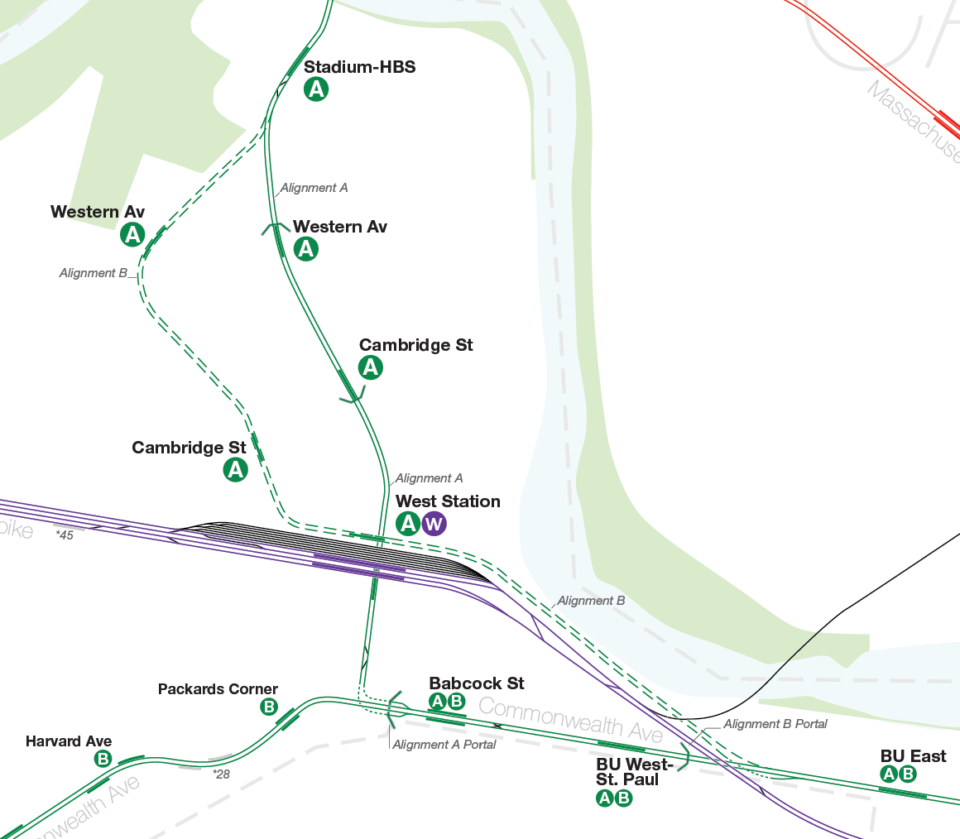
The new A Branch could help by connecting the new neighborhood with Harvard Sq and Comm Ave. This will be more complex than it seems at first but if built while the land is already being redeveloped it will end up costing far less to build now than once the land is full. There are two options for the alignment: the first would have the A Branch running along Comm Ave to Pleasant St where between Pleasant and Babcock Sts a new portal would be built in the middle of the median. Doing this would require taking a lane of traffic on each side of Comm Ave which would be offset by removing the parking lanes for this block. The new tunnel would turn north under Babcock and would dive below BU, the commuter rail tracks and the relocated Mass Pike. The station would also act as a pedestrian connection between the new neighborhood and BU as BU has refused to allow any new streets be built through its land. The second alignment would involve extending the tunnel from Kenmore west to Armory St with a new, single Boston University East station along the way. Around the BU Bridge the tunnel would split with a flying junction so that A trains would run under the Mass Pike and ascend along the Grand Junction tracks, following the newly aligned Mass Pike at grade to a new station parallel to West Station. The B Branch would continue west a few hundred feet before coming to the surface around Armory St. The first alignment would continue north through land which is to be redeveloped so that a shallow tench or short tunnels would suffice but the second alignment would require building a new tunnel from West Station along North Harvard St which would cause much more disruption.
Stations along the line would be at West Station, Cambridge Ave, Western Ave and North Harvard St at the Harvard Business School. From North Harvard St the line must dive below the Charles River to continue to Harvard Sq. The line will use an abandoned section of Red Line tunnel to terminate within Harvard Sq. The Red Line once terminated at Harvard and there was a maintenance yard just south of the square with a three track tunnel connecting to the station. When the Red Line was extended to Alewife this yard was sold to Harvard which built their Kennedy School of Government in its place. The tunnels, however, still remain as does a ROW through the two buildings to Brattle St. The new A Branch would enter these tunnels and where one of the tracks would be replaced by a platform. The exiting tunnels are located next to the Harvard Station mezzanine meaning that the side walls could be easily opened up for transfers to the Red Line and bus lines.
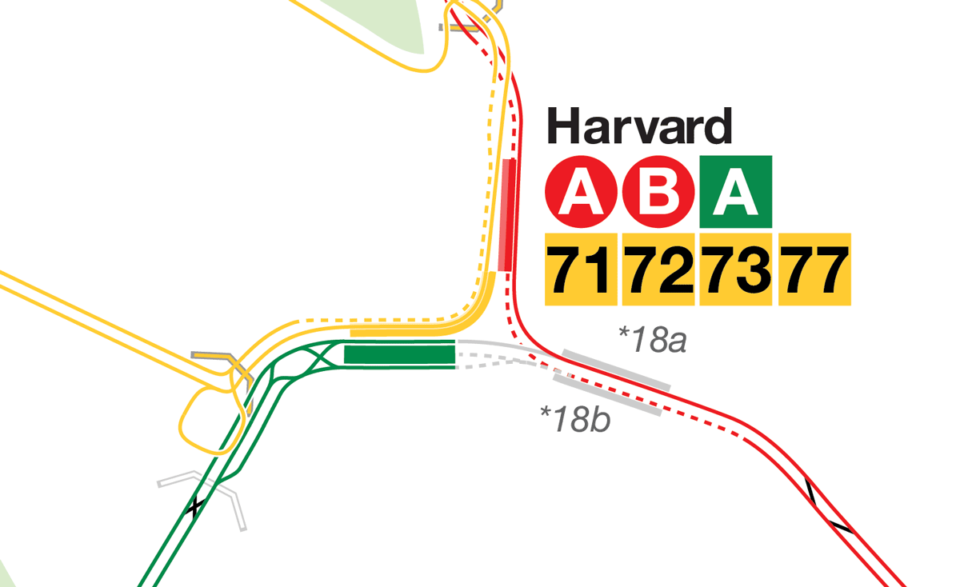
Building on my critique of the Grand Junction as rapid transit this new A Branch would better serve the Cambridge Boston-West market. One of my pet peeves about new rapid transit lines is that they often exist by themselves and not part of a greater network. Rapid transit on Grand Junction is basically just a shuttle between Allston and North Station but an A Branch would feed into the existing network and actually improve on popular routes. While not as detailed as the old Urban Ring proposal the A Branch would connect Harvard with Longwood via Kenmore Sq. The new branch would have a built in ridership and riders coming from the northwest Red Line or west via bus routes would could use the new branch to access Back Bay without needing to go downtown. Imagine not having to ride all the way downtown just to turn around and head back out.
Orange Line
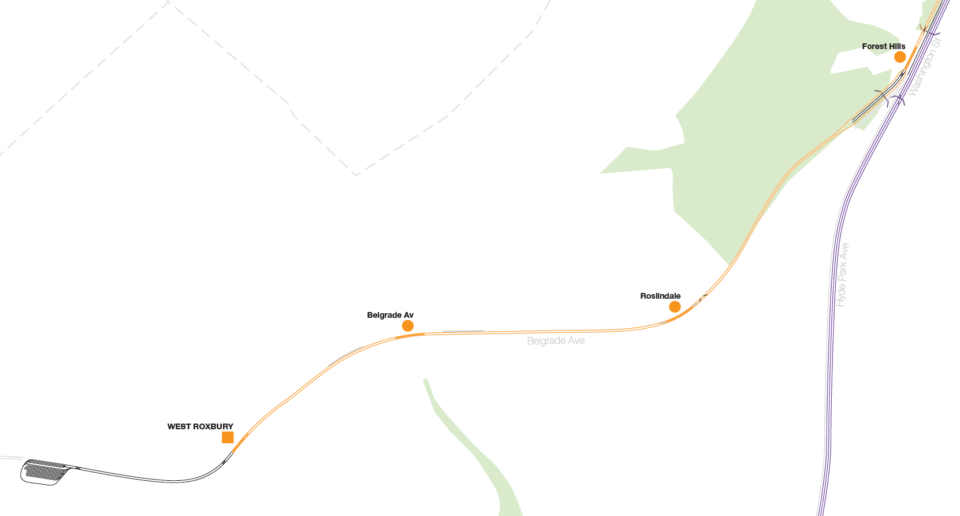
Though most of this post is focused on how a reconfigured Green Line would revolutionize travel around Boston there is one additional project that needs to be added. When the E Branch replaces the Needham commuter rail line this will cut off the stations in Roslindale and West Roxbury. Replacing the Needham Line is an all-or-nothing proposition so by extending the E we must also extend the Orange Line. There are other benefits to such an extension. Right now between Roslindale and Forest Hills marches an army of buses every rush hour. Most of these riders are headed to the Orange Line and not the commuter rail so extending the Orange Line means taking hundreds of buses off the streets. The Orange Line is also maxed out on service due in part to the limited number of trains. Wellington is the only train yard and a second one will be needed to boost service. To avoid redeveloping wetlands along the route there seems only one suitable location which is to redevelop the strip mall along Gardner St west of the VFW Parkway. I might even endorse a new terminal station here but that would only encourage development along the Charles River wetlands and this should be avoided. A second possible location would be just north of the Dedham Mall but this would require tunneling under a residential neighborhood as the former ROW to Dedham has since been built over. If the Dedham location should prove worthwhile then a new terminal at the Dedham Mall would be included.
Lest the reader get lost in this grand vision keep in mind that the most important section, the Essex St Connector, can be done first and the rest is a speculation on what would help the network in the future. Fixing the crush downtown is priority number one so creating new transfer points at South Station and with the Blue Line at Charles/MGH is what the MBTA needs to be studying today. The Seaport will choke on growth if transit is not addressed and congestion downtown is causing cascading delays throughout the system.

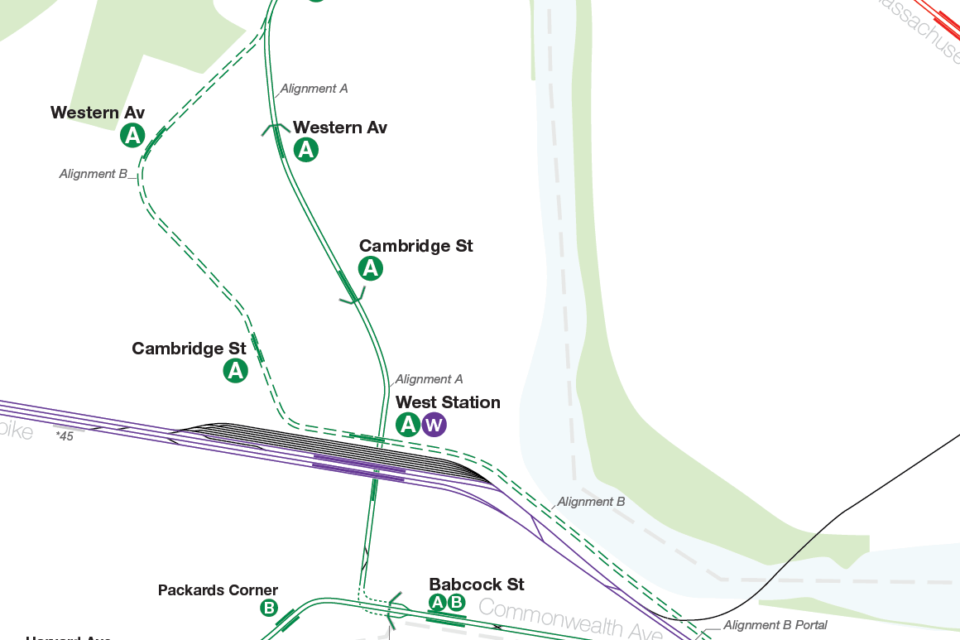
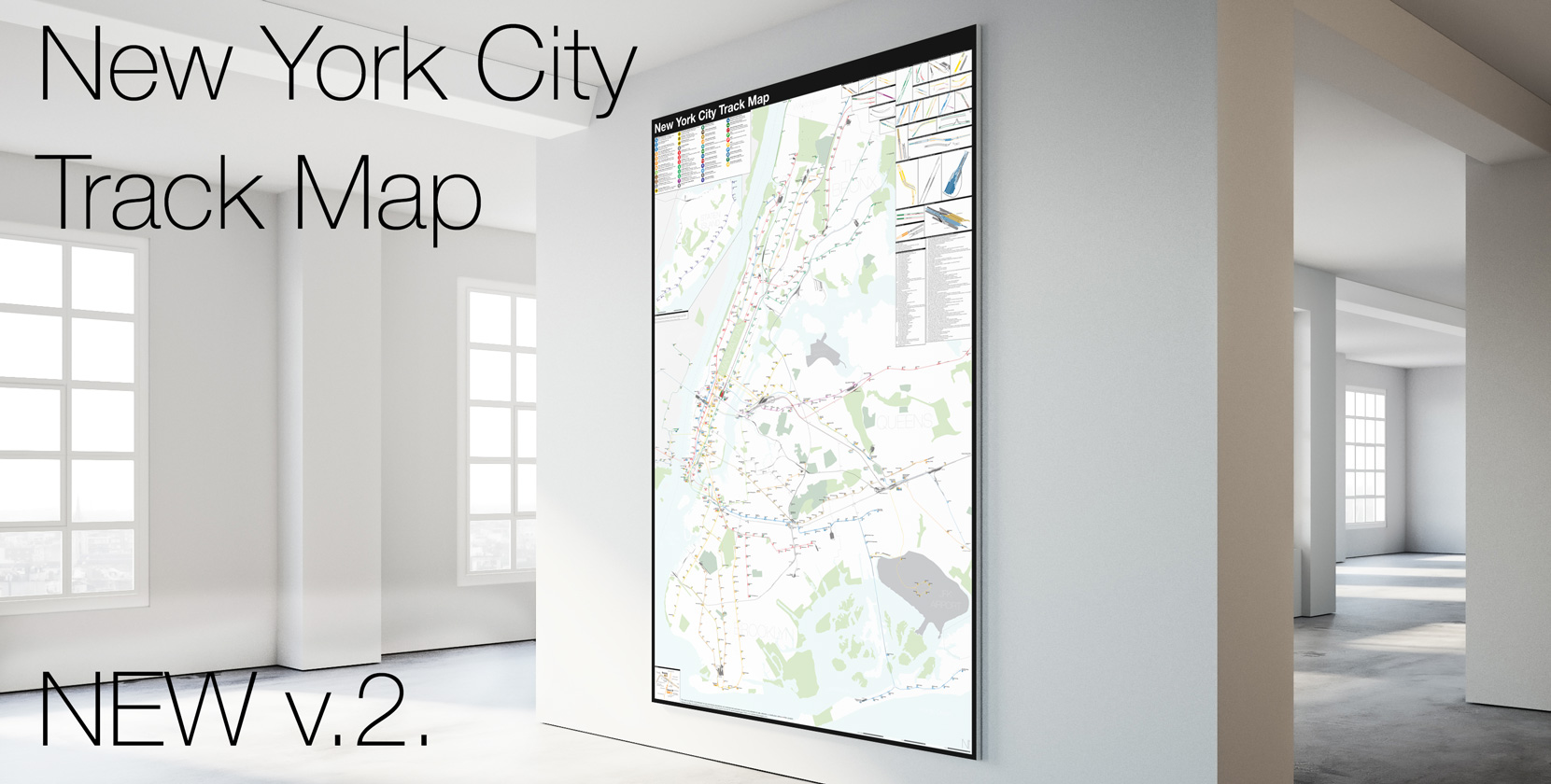
– MIXING BUSES AND LIGHT RAIL: I don’t think I understand why the bus is limited to 15 mph. What about operating on pavement instead of rail requires that? Bus run at much higher speeds. Is this just MBTA institutional operating problems? Or something else? Is the something else solvable?
If it IS solvable, there are a number of possibilities. Most obviously, route the silver line buses into the Tremont St. subway portal and on to Park Street. Route the Charleston buses from the north into the subway to Govenment Center.
– I fear that routing the Riverside line via the E line would add a lot of running time. Would it? If so, that is not viable. How much Riverside ridership would to to the Bridgham Circle area or Northeastern? Maybe some runs should go that way or some E line trains terminate at Brookline Village?
– If you are proposing an orange line to West Roxbury, why stop there? Why not continue through Dedham to Route 128 at Dedham Corporate Center and on to Norwood Central. Like the Stuart St subway, this is an old proposal.
– Your A line through Allston to Harvard is the seed of an important idea. But it could also be an extension of the orange line, or a second route of the redline, running through Bacy Bay and linking to the route ending at the Cabot Yards, giving south shore passengers a quick way to Back Bay.
– Why no love for restoring the A line to Watertown and the E all the way to Arborway?
– It’s that the bus runs in a tight tunnel with no guideways. This requires the driver to control the vehicle themselves which is more dangerous. Hence the slow speed limit. As for your second suggestion this is not possible as the original subway tunnels are not large enough for buses. This was the big issue in SL Phase 3 which required demolishing the existing tunnels to build larger ones.
– The new route would in fact be longer but not by much. It would be a trade off for more service. And you are correct about short turning E trains at Brookline Village, this is why I included a layup track past the new station. Additionally the new loop at BV would allow for through service. The whole idea is to eliminate bottlenecks like at Kenmore and Copley and adding capacity.
– Funny enough this was what I was going to propose originally but cut the plans back to just focus on reusing the Needham Branch. Going to Dedham faces a few expensive challenges. The ROW of the old railroad has been redeveloped so this would require land taking and tunneling under streets. Then you have to deal with the fact that much of the land along the VFW Parkway is marshy so you’d need to run trains along an elevated viaduct through Dedham Center and south to 128. It’s not impossible but way more complicated and I wanted to keep it simple for now.
– I’ve never liked the idea of splitting the Red Line like that. It would absolutely ruin the system. Even with transfers the major destination of riders is downtown. Splitting the RL means halfing service to the most congested stations. If there was a separate tunnel that wouldn’t interline with the RL like the Urban Ring I’d be more in favor of that.
– I am not in favor of bringing back street running. Given the narrow widths of Boston streets buses are the better option.
Excellent piece.Lots of great ideas in here but also very expensive. With so little funding out there and so much need, the MBTA will be forced to prioritize. After the downtown part of your plan which I agree has to be fixed soon, an urban ring line seems next in importance. One idea I’ve heard would be to convert the commuter rail lines to a “show up and ride” system, like BART. This would negate the need to extend some of the rapid transit lines. PS. Essex Street does not cross Washington St. That stretch to Tremont St is the beginning of Boylston St.
I agree the downtown, Essex St Connector is really the most important part. The rest is just what could be possible. I’ve never been a huge fan of the Urban Ring only because the plans were so complicated. That said the growing popularity of bus lanes is without a doubt the single most important and affordable transit expansion that the region can undertake. Regional rail is up there too but requires the also totally expensive NS Link.
” Essex St between Tremont and Washington is only 40 feet wide so to fit with a new station the tunnels must be bi-level with the Seaport bound track on the upper level and the Kenmore bound track on the lower.” – This is the sentence that ought to be fixed.
Got it, thanks.
Great piece. The downtown and Stuart St subway are both good ideas. Since the western portions have a lower immediate priority, I would suggest considering alternative routes of the A-line or a new line to travel through Watertown as a subway. It is too close to the city to not have any one seat or train/train transfers. The 57 bus is constantly packed and there is a lot of development on Arsenal st that is already causing large amounts of traffic in town since there are no good public transit options. It seems like a lot of people being priced out Cambridge are moving west there. I don’t think it would be terrible to put a tunnel under Western Ave/Arsenal St. as they are plenty wide.
Also, in the BU west section it should be Amory st, not Armory St.
I fully agree with you. I am working on a plan for that but decided to not include it in this post just to keep things simple.
What about the green line extension from Lechmere through Somerville to Medford? Isn’t that deserving of an update? would appreciate one. thanks.
But that’s already actually happening. Although I suppose I can add it to the big map now.
Outstanding work as always, van!!!
Some minutiae comments I’ll break into a couple posts since there’s a lot to work with here (and, help me, I’m always that long-winded 😉 ). . .
OPERATIONS-only
————————
HARVARD BRANCH SPLIT — Alignment A’s extremely sharp angle at the bottom of the duck-under incline will create a distended slow zone backing up into the junction and Babcock Under platforms. Unintended consequences of incline + angle (pinned in by building foundations) makes that potentially as dicey or dicier than Boylston Curve even if the absolute turn radius is gentler than Boylston. I think you will have traffic management concerns backing onto the Babcock platforms with the geometry enforced by those city blocks, so avoid that risk if at all possible. Alignment B’s 30-degree or less angle will let you take off like a rocket towards West Station, and the time savings are probably worth more on total ridership for the 66 crosstown’er crowd than the difference in being able to cram BU West and Babcock (which both share some catchment overlap with West) onto the same mainline.
You also need Alignment B if there is any future (beyond scope of your map) in which the Grand Junction is converted to light rail pinging from Lechmere/Brickbottom to BU Bridge, as staying on the northeasterly side of the Worcester Line is the only way to hit that insertion point. (NOTE from previous ArchBoston threads: North-South Rail Link is NOT a build prerequisite for taking the GJ off the RR network for conversion LRT duty so long as north vs. south Purple Line equipment/facilities are beefed up for less interdependence, so the UR build can go anywhere on the overall priority pile without necessarily being subservient to a different megaproject). The trajectory for Alignment B allows for enough running room post-split for a second junction onto the hillside at BU Bridge, and pretty elegantly keeps the provision for a Grand Junction hook-in intact if you run it more or less as depicted on your map. Whether or not GJ light rail is in the cards on your particular vision, the Urban Ring is a big enough consideration unto itself that lumping the 100-year future-proofing in with the other strictly within-scope performance advantages of Alignment B makes choosing the B trajectory a no-brainer on value-for-money.
BU EAST STATION — As a nod to Alignment B and future-proofing possibility of it handling much more traffic in a speculative Urban Ring hook-in scenario, you would probably want to change the platform layout to 2 side platforms instead of center, leave extra slack space along the walls, and keep egresses dropping down mid-platform instead of wall-side. That way if future needs arise you would have space to drop second tracks on the wall side, flip the junction to before instead of after the station, and have a Kenmore-like setup where BC and Harvard + MIT stop on separate berths and can thread in orderly fashion. That platform config is surplus-to-requirement if it only ever ends up being just BC + Harvard, but Comm Ave. is so wide in front of Marsh Sq. that you can easily pour ultra-wide side platforms with set-back walls and have all future considerations covered within similar cost. So set-it-and-forget-it there.
NEEDHAM BRANCH FACILITIES — Needham, given where it splits from the D mainline, will have ops triaged out of Reservoir like the B and C rather than Riverside like the D. That requires an end-of-line yard least as large as the B’s Lake St. Yard (70,000 sq. ft.), including similar 1-2 bay inspection garage + staff office given the longish distance to the next-nearest base. Also needs +10-20% extra yard slack so it’s not overly cramped if/when 3-car trains become an operating norm. The commuter rail layover isn’t nearly large enough for all that, so you’d be looking instead at the 175,000 sq. ft. inside the footprint of Needham Jct. wye, displacing Hartney Greymont, Inc. and the Needham DPW yard. That’s large enough to do a Lake St. + 10% -size yard, a DC traction substation attached to the adjacent Eversource sub, some misc. Maintenance of Way storage in the rear, and a turning loop. Looping is preferable to stub-end where land is available because of faster turnarounds with less wear on trainlining circuitry, and the faster turnarounds of looping could be consequential on some branches if Proof-of-Payment progresses to a point where Green goes to One-person Ops on multi-car trains some or all of the time like Red/Orange/Blue.
To fulfill those ops prereqs, the NJ station would need to flip from the old depot building on Junction St. onto a new set of platforms across the street constructed behind Roche Bros…placed right before the yard + loop in a Riverside-like setup. Largely cosmetic change for passengers, but placement-dependent on the ops need for the facilities inside the wye real estate. Note that even with the facilities there you still have nearly half of the wye square footage (which is otherwise pretty low-value land) to devote to building parking or TOD.
BROOKLINE VILLAGE STATION/JUNCTION — Very space-constrained here to do stacked platforms and a yard tucked within a cut that’s barely 65 ft. wide, and not do any damage to surrounding buildings. You may need to spread the risk around by considering some Alt. ‘B’ alignments that cut narrowly across Mission Park and Brookline St. Playground for mainline merges/loops further east, and some Alt. ‘C’s that do a narrower profile at-grade junction of a shallow portaling-up Huntington tunnel merging with the surface D where 10 Pearl’s parking garage driveway is. Everything’s very tight and tricky…but this is a so very big a “get”…so cover the field well by sketching out multiple Alternatives for further study. Note also that the challenges of just getting relatively clean junctioning and platform siting for flex-ops from either mainline is almost certainly going to preclude any practical chance for a useful yard, so trains will have to proceed to Reservoir for first schedule-robust opportunity at a short-turn. Onsite yard is really too big an ask given overall degree of difficulty with the junction siting.
Other possible consideration to consider, depending on how the potpourri of junction/platform Alt.’s stacks up: surface turnout onto Pearl St. west of the platforms. Since the current platforms are level with the western end of Pearl, anything you can do to keep the new infrastructure situated east allows you chance at sticking an at-grade turnout onto Pearl for curbside pickup. This can serve as an alternative to full BV short-turns in lieu of any space for a mainline yard by replicating the old “North Station Under” setup pre- Big Dig where C’s used to turn and layup curbside on Causeway St. Nothing weird or unknown about that setup, other than it would probably only have similar capacity as Heath Loop (2 simultaneous trains max).
OR…curbside turnout onto Pearl can preserve full streetcar service on South Huntington that’s otherwise eliminated by the new tunnel alignment. Consider that there have been many official, low-priority proposals over the years for D-to-E surface connecting trackage from BV station to the Huntington/S. Huntington intersection for purposes of service layering on the E as well as better non-revenue equipment transfers. Similar to how separate E service layers used to run as separate Lechmere-Heath and Park-Arborway patterns every M-F peak pre-1985, with just the default Arborway patterns handling off-peak. Regardless of what intersections such street trackage would choose to take to get between S. Huntington and Pearl St., such a build is considered perennially cheap, fungible, and pick-up-and-go should the T ever see critical enough mass to go forward with it. Given that such a surface connection is perennially cheap/fungible, your map of the reimagined Huntington subway can include full routing capability to Heath/Hyde Sq. and/or beyond to Forest Hills on any of the build Alts. that manage to fit the junction east of the Washington St. overpass. Since build practically forces you to throw out some ‘B’ and ‘C’ Alts. for study to cover the construction risks around the space constraints, make sure that the Alternatives scoring takes into account (even if only as secondary consideration) the routing and short-turn advantages of being able to hit that Pearl turnout provision. Maybe that’s not central to your GL Reimagined core goals…but it’s a potential best-of-all-worlds to keep in-pocket, since a preserved S. Huntington branch that came off the BV merge of two grade-separated mains would be much faster and run into less traffic than the current E trip up Huntington, and would have the scheduling flex to slice/dice routings from either Huntington or Kenmore directions while throttling-up/down service levels with much more precision than today. You could, for example, run throttle-up Kenmore Loop-Forest Hills extras at peak-most when transfer headways are at their most optimal…but manage to keep that surge service safely out of every other schedule’s way by dispatching means not possible on today’s GL network.
Fantastic analysis F, I do miss you insight.
A Branch: Originally I wasn’t a fan of Alt B but you’ve definitely swayed me in thinking it’s the more preferable option. I was avoiding using GJ but should NS Link be built you wouldn’t need it and the ROW could be converted to light rail and this junction would be more workable. Thanks!
Brookline: I’m going to avoid any plans that involve using more street running because if you are going to all the trouble why not do it right? Rt 9 is quite wide and would have space for what I’m proposing but it would also be far more complicated. I feel that with a Mission Park/Brookline Ave Park alignment would be more confined and the loop would be more difficult. But I haven’t drawn it out so maybe it’s worth pursuing.
Needham: I was assuming that the unused CR tracks past Needham Junction could be used but you bring up an important point about yard access. A wye may be possible at the Newton Highlands junction, though it would have to run through a power transformer. Either way good points.
Van,
With GJ-to-light-rail you aren’t dependent on NSRL being built first at all. You simply need to fortify the north vs. south Purple equipment independence enough that the backup equipment swap route via Worcester-Ayer only has to be used once or twice a week for moves, instead of once or twice per day like the current GJ. Simply electrifying all Providence/RIDOT + Fairmount + Worcester service on EMU’s and converting Needham to rapid transit ends up displacing 60% of southside commuter rail’s fleet needs right off the bat to electric vehicles that (initially, at least) are going to live exclusively at southside yards and maint facilities. That’s even before you get to the easiest of the next-wave electrifications like Franklin and Stoughton. If that electric facility also had lifts for maintaining coaches, and you had additional room for southside work equipment…then the only things you’d need to thread north to Boston Engine Terminal are the remaining southside diesel locos for inspections and any particularly heavy repair jobs. There you go…daily moves reduced to once or twice a week. The Worcester County scenic route, being a major (if negligently maintained) freight main…then just needs enough TLC to get its speeds up from 10 MPH to 40 MPH passenger track class to do a par job as the Grand Junction on cost/fuel/crew for those much-reduced swap volumes.
Voila…completely expendable Grand Junction! In as near-a-term as they want it if they choose to eat their peas on commuter rail fortifications.
For Brookline I think you’re going to need to matrix a few build scenarios given the extreme difficulty in threading the needle. The building impacts are real, so it’ll take a few alignment Alternatives…and not all of them are going to be able to provide every single kitchen-sink frill for tri-directional service run elegantly through a single-point BV platform location. What may be useful there is to scope out the construction alternatives, whether it’s a thru-running junction east in the park well shy of the platforms or one of several Alts. that try to merge at/around the current platforms with ever-simpler junctioning. Compare with sources of ridership…and for here the crosstown’er crowd on the 66 and the UR studies (which all, whether BRT or LRT, bullseye on Kenmore as a transfer superstation). A lot of those crosstown sources are very Longwood-centric. How well-served are those crosstown riders by pumping the headways at Kenmore such that upstairs/downstairs and cross-platform transfers from B+Harvard+UR to D+C+’Huntington circuit’ are plentiful and effortless, and does that lessen the need to hit a construction hole-in-one with an Absolute Perfectionâ„¢ BV station configuration? Mix/match ridership vs. construction combos on that matrix to arrive at at least 2 Preferred Alts. you can live with as meeting most major CORE project goals even if they don’t end up meeting EVERY project goal. The uncertainty level with tunnel routing feasibility is very high here…at least a potential for +/- 2 block swing in alignments east or west until an EIS-level engineering assessment happens. So make sure your overall scheme can live inside of that level of alignment uncertainty and still hit on its key objectives. The less the whole works is predicated on hitting Absolute Perfectionâ„¢ with the BV alignment, the more robust it’ll be when engineering does whittle down the feasibility.
This would be a textbook example of learning something useful from the failure of the Urban Ring Phase III’s unbuildable cross-Brookline tunnel alignment. They asked for a home-run swing, all-or-nothing. And when each individual block of streets started chucking out construction problems, stiff opposition, and billions in potential overruns…the whole scheme fell apart and they got nothing. Being able to matrix out the USEFUL…rather than perfect…service patterns within that +/- 2-block alignment fudge factor is the literal difference in getting shit done here!
So if that means firewalling Longwood because the junction has to be too far east for BV Station to be all things to everyone, make sure that outcome checks out with your demand sources (spoiler: it probably does). And as far as streetcar forking to JP-via-BV goes…if you end up with a more easterly junction alignment that misses the BV platforms on some routings, what else is there in the toolbox to make up the difference? I mention the fungibility of the S. Huntington-BV street trackage in part because in the event you can only thru-route KenmoreD/LongwoodE/Brigham (etc.) circuit service without hitting BV there’s upside in being able to thru-route a JP Branch streetcar from BV from either Kenmore or Brigham directions that it offsets some of what you lose by not being able to hit BV on the ‘circuit’ alignment. One engineering setback on most-preferred alignment thus doesn’t end up tanking the whole scheme, because you found some additional offsets with upside. Now, I realize streetcars are not central to this vision…and that’s perfectly OK. But I wouldn’t preclude useful offsets like this if natural uncertainty leaves an inherent risk of only getting 70% of the flex you seek out of the core alignment. Keeping the universe of future-proofing options and problem-solving offsets in mind as you game out the uncertainties is, as described above, a major leap forward in best practices from how the T has previously shipwrecked itself staking its megaproject studies to monolithic builds with no means of course correction when things start EIS’ing out unfavorably on a core alignment.
You’ll need to ballpark some similar alts for the South End routings, too. I won’t rehash those options because there’s umpteen pages of previous brawling on ArchBoston over those and everyone’s got their pet favorites (I certainly do, per my old posts). But if you apply the same logic of “maximizing my chances” by matrixing out the demand goals with the candidate alignments, you can narrow it down to 2 or 3 Alts. that would work despite the uncertainty of what lurks under Essex, Stuart, etc. There’s nothing inherently wrong with Stuart St., and obviously Essex was Silver Line Phase III’s preferred alignment all along. But if the cost overruns for Essex, etc. start stacking up in the billions all over again with an LRT build, you’ll want to say with confidence that you studied out the Alts under other streets enough to not have to bet the whole farm all-or-nothing on one choice that’s going to break the project. So rather than picking favorites, apply the same logic to the South End as with Brookline Vill. and sketch out 2-3 alignments that get the core job done. Than look at each–amid their various imperfections–and see what offsets of redeeming quality they have to enhance their value-added if that’s what the engineers say you’re left with. So, again…even though you’re not thinking streetcar branch at all for the idealized network, it helps to rank which of the South End alts. has the easiest and most fluid hook-in to a Dudley streetcar to help cover the spread. Having those considerations scoped out and in-pocket is what’ll help you recoup value if faced with a dilemma of picking a less-than-perfect alignment in the face of engineering/cost creep.
Basically…good rule of thumb anywhere the alignments are speculative like that and unknowable pre-EIS on true feasibility. Cross-reffing them against the universe of auxiliary upsides can inform which of the almost-but-not-quite perfect Plan B’s do enough to approximate any near-unreachably perfect Plan A’s. Could be based on diverging routes, could be based on transfer sources, could be based on relative proximity to some hot TOD, could be some other criteria entirely that helps recoup that value. But doing that exercise reinforces the integrity-of-concept of the build without shackling you to monoliths that have to be perfect to get built at all. I think Boston’s had enough transit monoliths fail to get built in the last 30 years that “flexibility is the new thrift” should be a new mantra going forward.
Needham and West Roxbury will politically never allow any increase in density. I’d focus your proposals where density is wanted. Also if you include some math about costs and ridership your proposals will quickly fall apart. Focus on dedicated bus lanes and signal prioritization and where the existing system has problems, not tens of billions of new spending. Focus on automated trains to reduce operational costs. Wealthy Suburban towns like Needham and Newton and including West Roxbury are non-starters from a Transit Equity point of view. The people who need good Transit are in minority towns not wealthy Needham who won’t even approve things like bicycle paths.
Tom I wholeheartedly agree with your assessment. Bus lanes and signal prioritization would have the greatest return on investment on any transit project in the city. New trains and new signals would boost capacity as well. But even with all of that the central subway is still constrained. As you said “where the existing system has problems”. Well the central subway has MANY problems. The reasoning for expanding transit to Needham and W Rox is not because they are the next places to see development but because the Northeast Corridor is near capacity and with the addition of high speed rail and South Coast Rail to Fall River and New Bedford the Needham Branch will become a limiting factor. Already a parade of buses are running up Washington St from Roslindale so while a bus lane would help in the short term, extending the Orange Line would do far more including reducing pollution. Furthermore the idea that an area will “never allow any increase in density” is short term thinking. Obviously none of this can happen overnight, and I was not proposing that this is a top priority, so as the current generation of home owners sell off or die and a new generation comes in things will change, as they inevitably do.
I agree that extending transit to under served, often lower income neighborhoods is needed and what I was trying to get across with this post was that if the central subway is maxed out how to you propose to add new branches and extensions to these areas? If an F Branch to Dudley was added today it would be severely limited in capacity to the point where the Silver Line, as it is now, is actually a better alternative because you can run more buses. With a reworking of the central subway this opens up capacity. I think a major fault of mine in writing this piece was not including a Dudley branch but this was only done for clarity. Perhaps I will add a post script on the potential for future readers.
Tom…
West Roxbury may not have a choice because of the grim picture the NEC FUTURE commission’s traffic modeling paints for max achievable Needham Line frequencies in another 20 years. Without spending billions (already studied, already flunked on feasibility) widening of the SW Corridor tunnel to 4 CR tracks, Needham will never be able to achieve better service levels than today’s anemic schedule. And may indeed see actual cutbacks, such as being forced to shuttle as a dinky to an overcrowded Forest Hills terminal rather than running thru.
For this reason, conversion to Orange through W. Rox and Green from Newton Highlands to Needham Jct. is functionally non-optional for the medium-term future. You can extend OL to Roslindale as a down-payment today alongside CR since culling some buses at a Rozzie terminal would greatly improve the destabilizing congestion at Forest Hills and help with the obscene bus duplication/congestion on lower Washington St. That proposal has indeed made Mayor Walsh’s Boston 2030 universe-of-projects recs list, and neighborhood support. But the rest of the conversion through reluctant W. Rox will have to come someday because the “Big Squeeze” on the NEC is an inevitability.
Van…
On the OL map, there’s no need to consolidate stops as each has unique catchment. Rather, some re-positioning is in order. Rozzie, Bellevue, and Highland used to have grand old mixed-use station buildings (all of them either burned or were torn down from postwar blight), which is why there’s such absurd parking over-capacity at each and why Bellevue & Highland are slightly off-center on side streets instead of having platforms down in the ROW cut with egresses closer to square traffic & buses. West Roxbury is positioned too close to Highland because just south of Lagrange there used to be a large freight yard and junction with the old branchline to Dedham Ctr. and Islington, so Lagrange was the only place to have a station before the mass of track switches filled up everything through the Star Market & Catholic Memorial School parcels. Until 1958 W. Rox was a busy union stop for SS-Dedham-Readville-SS ‘circuit’ CR service, SS-Needham-Newton-SS ‘circuit’ CR service, and West Medway mainline CR service that all ran simultaneously through there. When the T rebuilt all these stops in 1986-87 during the Needham Line’s 8-year shutdown for SW Corridor reconstruction, they just kept all the historic stop locations verbatim as an afterthought rather than doing any fresh analysis about repositioning the outer 3 closer to the squares.
So, for your Orange extension Rozzie is stet (with a parking diet netting space for a high-capacity busway). But Bellevue probably moves 600+ ft. west in the cut between the Belgrade and W. Rox Pkwy. overpasses to catch the buses, Highland probably moves 800 ft. west to the Belgrade/Bellevue intersection (where your map pegs “Belgrade” station), and W. Rox moves 1500 ft. west behind Star Market on a TOD property that can tap looping Spring/Centre buses before they diverge + pull in the 52 up Baker St. + provide easier walking distance to the VA hospital.
For the Green fork you’ll want to consult this City of Newton presentation on stop placement: http://www.wabanareacouncil.com/sites/default/files/WabanHighlands2-29_1.pdf#page=49 (URL keys to the transit pages in the middle). Newton proposes stops at Needham St. behind a new apartment complex, Upper Falls, and New England Business Ctr. on the ‘down-payment’ Phase I extension to 128. City of Needham, with its separate advocacy, then wants the Gould/TV Place stop before swallowing the 3 CR stops to Needham Jct. to LRT. The Needham St. stop is a little bit soft/speculative on fundamentals so I doubt that makes the cut on anyone’s studied-out plan. Bbut NEBC has 2.5 million sq. ft. in redev potential, with an office shuttle proposed to run the circuit from the stop around the biz park to Kendrick St. That stop is probably going to be a must-have in any serious build plan because of the sky-high TOD revenue at stake. Note that because of its location on low-traffic Fremont St. next to the Charles River bridge it is not going to be a parking sink for 128 traffic; it’s primarily a walkup stop from the surrounding density with the circulator bus hitting the parking garages closer to Kendrick in the complex. Gould/TV Place thus is probably going to be the park-and-ride stop flanking the other side of 128 since it’s on higher-capacity streets and has the direct connection to Hunting Rd. to load-spread Pn’R traffic between the Highland exit and the new Kendrick exit. Plus there’s plenty of TOD to be had there at TV Place + the Muzi Ford parcel. Stop spacing would be 1450 ft. Upper Falls-NEBC with the river in-between, and 1900 ft. NEBC-Gould with the highway in-between…pretty fair given how the corridor has to cross 2 gaping chasms amid nonstop TOD density.
I’d amend your stop spacing to tentatively include NEBC and Gould, given what the demographic data is likely to demand for all that 128 TOD. That’s a safe bet when the time comes.
Great insight F. I have to admin this is one area of Boston I don’t think I’ve ever been through so I’m not familiar with the on the ground details.